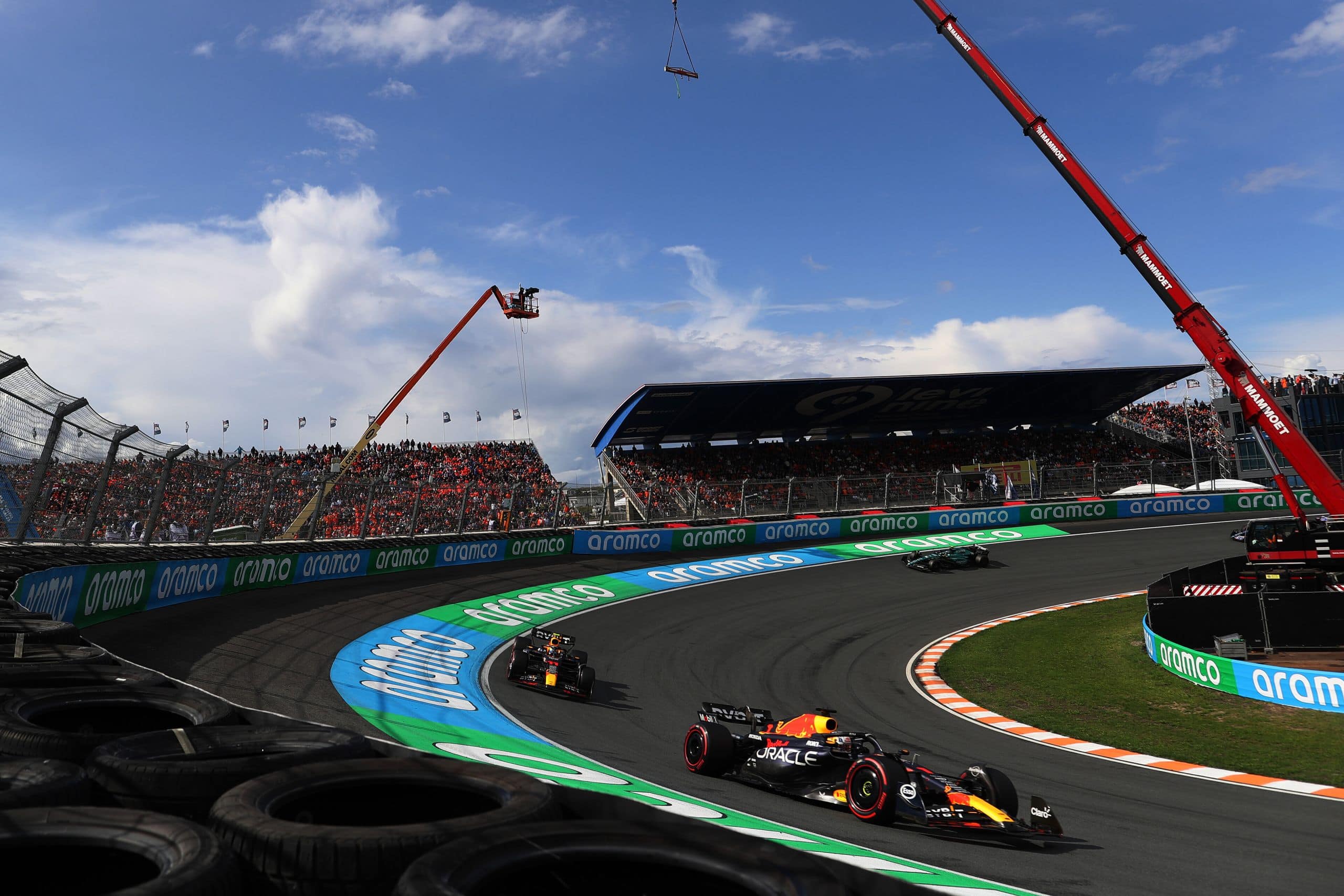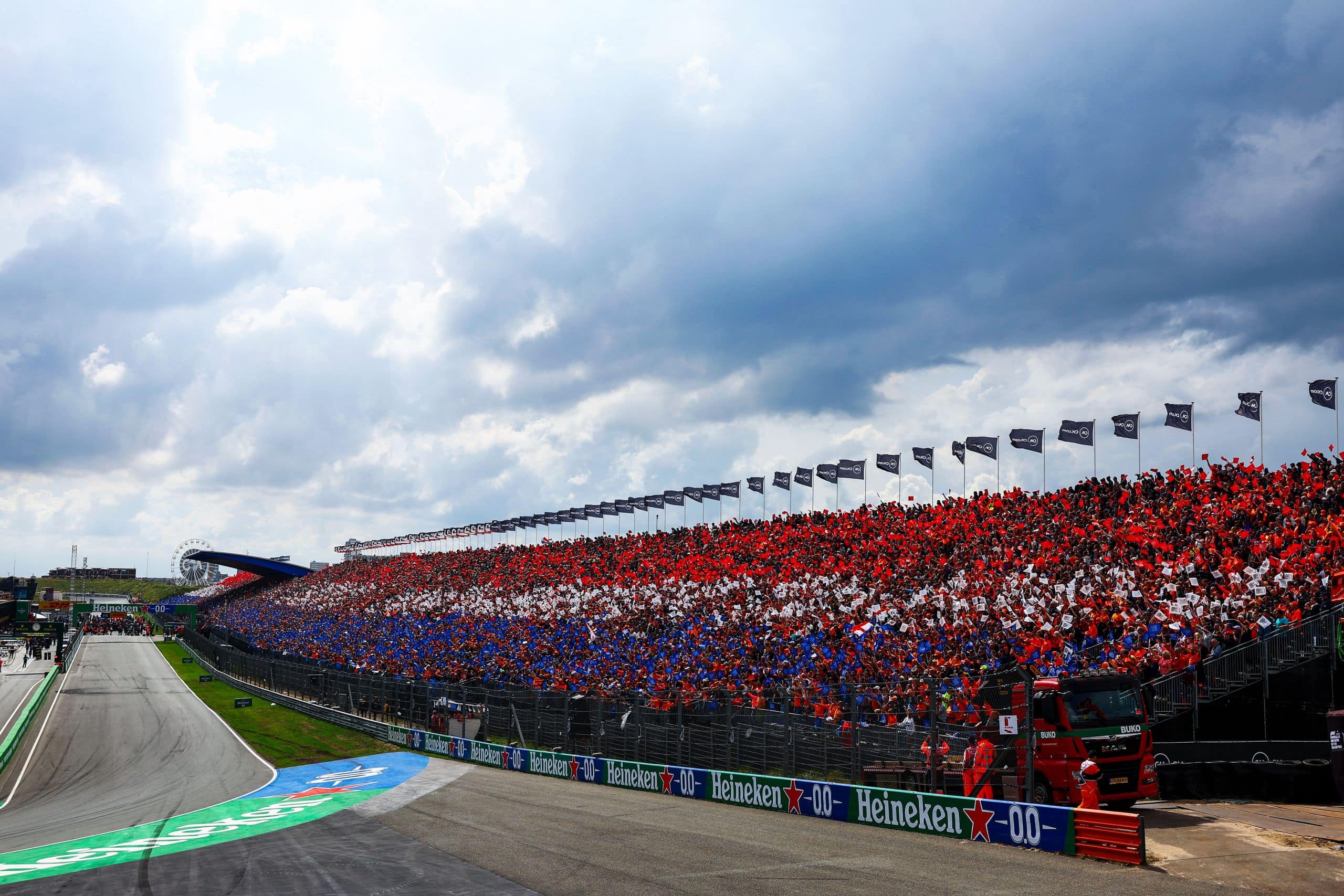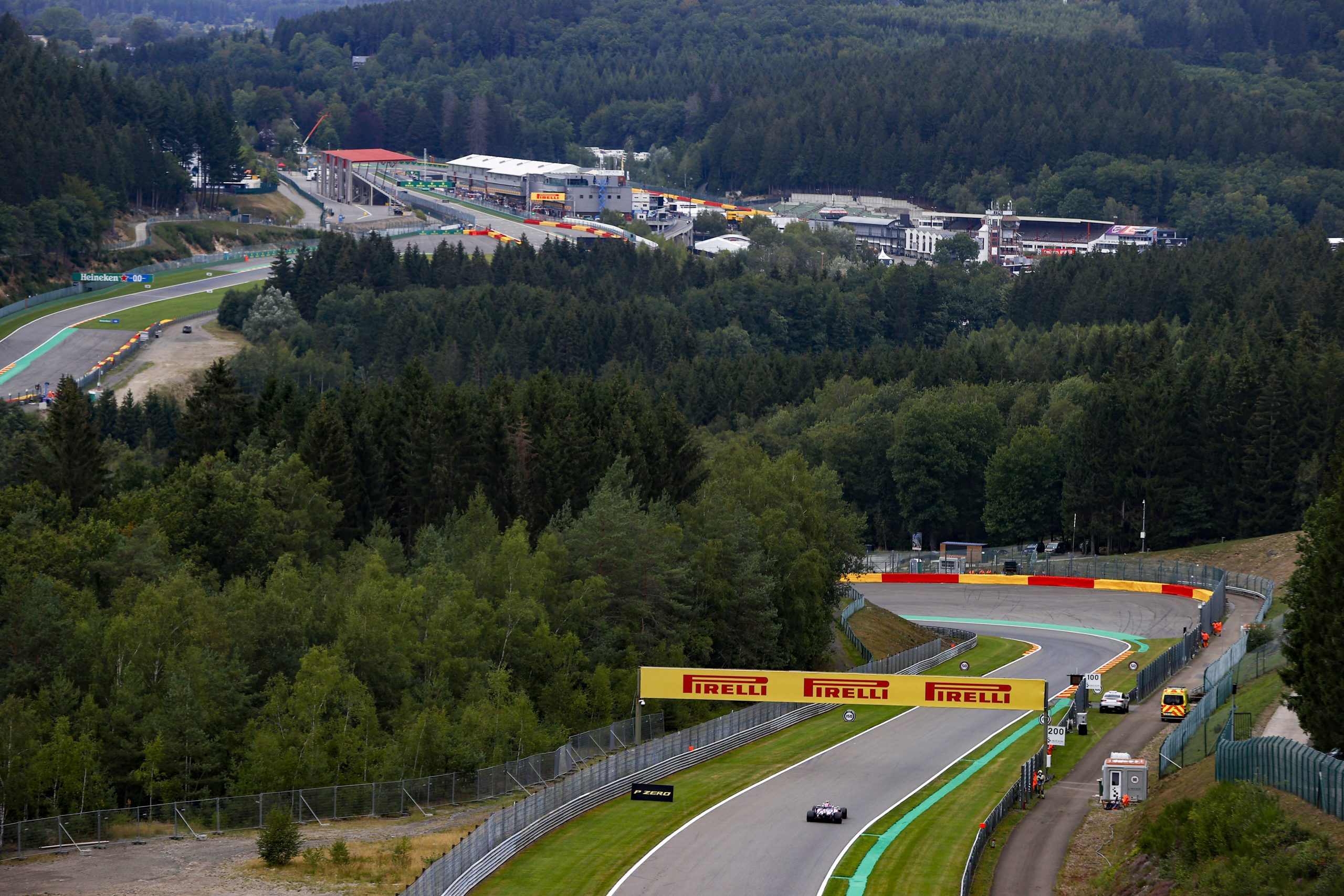Circuit Zandvoort
Circuit Zandvoort is a premier motorsport race track situated in the dunes just north of Zandvoort in the Netherlands, near the North Sea coastline. Known for its distinctive, challenging layout shaped by the natural dunes, this 4.3-kilometer-long circuit has gained fame for its fast, sweeping turns that offer a unique driving experience. It has a storied history in racing and has undergone various modifications over the years to improve safety and enhance the spectator experience.
As the proud host of the Formula 1 Heineken Dutch Grand Prix, Circuit Zandvoort marks its place on the Formula 1 calendar as a favorite among both fans and drivers. The return of the Dutch Grand Prix to the Formula 1 schedule in recent years has rekindled excitement around this historic track, known for its fan-friendly atmosphere and competitive racing.
The circuit’s blend of high-speed sections, challenging corners, and the ever-present coastal winds add significant complexity, making it a test of skill and precision for competitors. The renowned Tarzan corner, a notable feature of the race track, provides a prime overtaking opportunity, contributing to the dynamic and often unpredictable nature of the races held at Circuit Zandvoort.
History and Development
The history of Circuit Zandvoort is a testament to its resilience and adaptability over the years. This section covers the track’s origins, its evolution, and key historical milestones.
World War II and Origins
Amidst the daunting backdrop of World War II, the foundation for Circuit Zandvoort was laid. Initially hosting street races in 1939, it wasn’t until the war’s conclusion that a permanent circuit materialized. Utilizing German army roads built during the occupation of the Netherlands, and with Sammy Davis’s advisory on the track design in 1946, the first official race launched on August 7, 1948. The establishment was overseen by the Dutch Automobile Racing Club, highlighting the nation’s post-war dedication to motorsport.
Notable Historical Events
The Grand Prix Circuit, originally the Prijs van Zandvoort, was later known as the Grote Prijs van Nederland, marking its prominence in racing history. Alberto Ascari dominated the 1952 event, the first Dutch Grand Prix counted towards the World Championship under Formula Two regulations. The circuit became a permanent fixture on the Formula One calendar from 1958, accommodating the pinnacle of motorsport until 1985, including milestones like Jacky Ickx’s record-setting lap in 1970. The Grand Prix returned to Zandvoort in 2021, reinforcing its status as a mainstay in international racing.

Circuit Specifications
The Circuit Zandvoort is a testament to motorsport heritage, seamlessly blending traditional race elements with state-of-the-art design to challenge the skill of the world’s top drivers.
Track Layout
The Zandvoort track meanders through the Dutch dunes and offers a combination of high-speed sectors and technical challenges. The layout incorporates iconic turns from the original 1948 circuit, while introducing modern twists that demand precision and courage.
Length and Turns
- Circuit Length: 4.259 km (2.646 mi)
- Number of Turns: 14
- Turn Breakdown:
- 10 to the right
- 4 to the left
- Turn Breakdown:
Banked Corners
The track features several notable banked turns that provide unique overtaking opportunities and test the downforce limits of competing cars.
- Tarzan Corner (Turn 1): A wide bend that allows for overtaking.
- Hugenholtzbocht (Turn 3): A heavily banked corner redesigned to enable two cars to exit simultaneously at high speed.
- Arie Luyendijkbocht (Final Turn): Another banked turn leading into the main straight, often taken with minimal reduction in speed for a thrilling finish.
The innovative design of these key banked turns gives the Circuit Zandvoort a distinctive place in the world of Formula 1, providing remarkable spectacles of racing prowess.
Major Events
Circuit Zandvoort hosts a range of prestigious racing events that have both historical significance and contemporary appeal. The track’s challenging layout attracts a variety of competitions from single-seaters to touring car championships.
Dutch Grand Prix
The Dutch Grand Prix, also known as the Heineken Dutch Grand Prix, is a pinnacle event at Circuit Zandvoort and is part of the Formula One World Championship. The race has a storied history, having been included in the championship since 1952 and continuing after a significant break, from 2021 onwards.
Masters of Formula 3
The Masters of Formula 3 was another marquee event at Circuit Zandvoort, where the brightest talents from various national Formula Three series competed. This event showcased the up-and-coming drivers who were on the cusp of breaking into higher tiers of motorsport until its conclusion in 2016.
DTM and ADAC GT Masters
Circuit Zandvoort also serves as a venue for renowned touring car series such as the DTM (Deutsche Tourenwagen Masters) and the ADAC GT Masters. These events feature high-performance GT cars and are known for their intense wheel-to-wheel racing – a testament to the circuit’s challenging nature that emphasizes both driver skill and technical prowess.
Technical Aspects of Racing
Circuit Zandvoort presents a challenging arena for racing, with its unique corner compositions and a lap record that stands as a testament to the circuit’s demanding nature. A driver’s ability to navigate these technical aspects significantly impacts both overtaking maneuvers and qualifying times.
Overtaking Opportunities
Circuit Zandvoort is notorious for its limited overtaking opportunities. Drivers often target a few key corners where precision and bravery can result in successful overtakes. Turn 1, known as Tarzanbocht, is perhaps the most famous overtaking point on the track due to its wide entry and banking, which encourages different racing lines. Another notable section is the final chicane before the main straight, where late braking can yield positions.
Qualifying Dynamics
Qualifying at Zandvoort is critical, compounded by the track’s narrow nature and short overtaking windows. Drivers focus on extracting maximum performance from their cars in these sessions. Aerodynamics and mechanical grip play crucial roles, especially through the high-speed corners and rapid changes of direction.
Fan Experience
The Circuit Zandvoort provides a unique and thrilling experience for fans, situated amidst the dunes close to the North Sea’s coastline. These natural features along with the zestful Dutch supporters create a vivid atmosphere during the race events.
Viewing Areas
Circuit Zandvoort offers diverse viewing areas for spectators to catch the high-speed action. The speed aficionados may occupy spots along the main straight, where grandstands such as the Ben Pon, main, and pit provide clear views of the cars thundering down the track. The Tarzan-In grandstands give fans an upfront look at daring overtakes at the circuit’s first turn, Tarzan Corner, which is infamous for its challenging braking zone.
To get a glimpse of the impressive Arie Luyendyk corner, fans can secure positions in the Ben Pon stand, where cars flex their aerodynamic prowess around the banked curve. Additional stands like the Arena In, Arena, Arena Out, and Eastside offer diverse perspectives of the track as laps conclude and cars navigate towards the finish line.
Race Fan Engagement
Circuit Zandvoort engages fans beyond the viewing areas, with an assortment of engagement activities hosted at Racesquare. Here, fans are immersed in various interactive experiences, keeping the excitement high even when the cars aren’t roaring past. Live entertainment, behind-the-scenes access, and other activities such as free practice sessions bring fans closer to the action and are designed to enhance the overall spectator experience.

Safety and Regulations
At the CM.com Circuit Zandvoort, safety measures are meticulously implemented to ensure the well-being of everyone in attendance. These measures are aligned with those mandated by the FIA, ensuring a high standard of safety for all events, including the FIA Formula 3 European Championship.
Noise Regulations:
- The circuit adheres to strict noise regulations to minimize impact on the environment.
- Specific noise measurement protocols are in place to monitor compliance.
Paddock Regulations:
- A set of paddock rules exists to maintain safety in the paddock area.
- These rules are publicly available and aim to protect all persons present.
House Rules for Visitors:
- Visitor behavior must respect public order, decency, and morals.
- Guidelines are provided to maintain a controlled and safe environment during events.
Track Safety Enhancements: Zandvoort underwent significant modifications to meet F1 requirements, which included:
- Installation of steep curves to maintain sufficient speed without extending the straight, prioritizing driver safety due to the track’s unique constraints.
- Turn 3, the Hugenholtz-Bocht, specifically designed to be not only a visual spectacle but also an overtaking opportunity while ensuring secure racing conditions.
Circuit Zandvoort’s commitment to safety and adherence to regulations ensures a secure experience for racers and spectators alike. The management successfully balances the preservation of the track’s historical essence with the modern enhancements necessary to comply with contemporary racing standards.
Circuit Zandvoort – Frequently Asked Questions
Circuit Zandvoort is a venue rich in motorsport history, attracting fans and queries alike. Below are answers to some of the most commonly asked questions about the circuit.
How can I purchase tickets for events at Circuit Zandvoort?
Tickets for events at Circuit Zandvoort can typically be purchased through the official website or authorized ticketing partners. It is advisable to check the circuit’s official platform for the latest ticket sales information and availability.
Why did the Dutch Grand Prix stop?
The Dutch Grand Prix originally ceased to be part of the Formula 1 calendar after the 1985 race due to financial difficulties and the inability to meet the required safety standards at the time. However, it returned to the F1 calendar in 2021 after significant upgrades to the circuit.
What town is the Dutch Grand Prix in?
The Dutch Grand Prix is hosted in the town of Zandvoort, located in the North Holland province of the Netherlands. It is situated by the North Sea and is a popular beach resort as well as being known for motorsport.
Who currently has ownership of Circuit Zandvoort?
Circuit Zandvoort is owned by Chapman Andretti partners, an organization involving Bernhard van Oranje, a member of the Dutch royal family, and Menno de Jong. They have invested in the development and promotion of the circuit.
Can you walk on Zandvoort Circuit?
Walking on Zandvoort Circuit is not regularly permitted due to safety regulations and operational procedures. However, there are special events and track days when the public may have access to the track on foot.
Has Max Verstappen won the Dutch Grand Prix?
Yes, Max Verstappen has won the Dutch Grand Prix three years in a row from 2021 to 2023. Verstappen won the 2023 Dutch Grand Prix on August 27, 2023 for his record-equalling ninth straight race victory of the 2023 F1 season.

